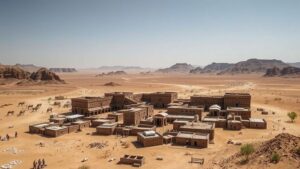Searching for clues to Aratta, a mythical city mentioned in Sumerian legends.
Searching for Clues to Aratta: A Mythical City in Sumerian Legends
Aratta, a city steeped in the mystery of Sumerian mythology, has fascinated historians, archaeologists, and enthusiasts for centuries. Frequently depicted as a land of immense wealth and advanced civilization, this mythical city is mentioned in various tablets and literature from ancient Mesopotamia. This article aims to explore the clues surrounding Aratta and delve into its significance in Sumerian history.
The Sumerian Context and the Significance of Aratta
The ancient Sumerians, who thrived in Mesopotamia from approximately 4500 to 1900 BCE, are often credited with the development of one of the earliest known civilizations. Amongst their contributions to written language, law, and agriculture, the legends of Aratta stand out. Aratta is frequently portrayed as a source of lapis lazuli, gold, and other valuable resources, emphasizing its importance in trade and culture within the Sumerian worldview.
For example, the famous Sumerian king, Gilgamesh, speaks of Aratta in the context of an epic journey, symbolizing not just an actual quest for resources but also representing a pursuit of knowledge and cultural exchange. The riches of Aratta are highlighted in texts that suggest it was a civilization that rivaled Sumer itself in wealth and sophistication.
Historical References and Clues
Aratta is primarily known through the “Lugalbanda in the Mountain Cave” text and later writings, notably the “Epic of Gilgamesh”. earliest reference dates back to around 2600 BCE when Sumerian texts began to emerge. Scholars propose that its exact location remains elusive, with various theories suggesting it could be situated in present-day Iran or the region near the Zagros Mountains. While no definitive archaeological evidence links any specific site to Aratta, historical clues continue to spark debates.
Archaeological sites that have been speculated to represent Aratta include:
- Tepe Sialk: Found near Kashan, Iran, this site exhibits signs of advanced metallurgy and trade.
- Shahr-i Sokhta: An ancient city known for its elaborate burial practices and potential wealth during the Bronze Age.
Mythology Versus Reality
The distinction between mythology and reality blurs in the search for Aratta. While many considered it a mythical place solely rooted in Sumerian lore, some historians argue its existence could correspond to actual cities that fell out of historical records. The qualities attributed to Aratta, including grand temples, extensive administrative systems, and its wealth, may reflect the characteristics of real-life cities in the region during the ancient period.
For example, Arattas mention as a land with direct trade relations invariably aligns with Sumer’s known trade networks, further blurring the line between myth and fact. As per the available data, the trade routes connecting Sumer with the Indus Valley and beyond illustrate a complex interaction that could have inspired the tales of Aratta.
The Search for Aratta: Archaeological Efforts and Challenges
Despite numerous archaeological efforts, locating Aratta has proven challenging due to several factors, including the vastness of ancient Mesopotamia and the potential for conflated historical narratives. modern archaeological community has employed methods such as satellite imaging and ground-penetrating radar to identify possible sites, but results have been inconclusive.
Prominent archaeologist Dr. Elizabeth Stone emphasizes that dismissing Aratta as mere myth might deny the possibility of discovering substantial remains of a civilization that contributed to early human history. The discourse surrounding Aratta reflects larger questions of cultural memory and historical legacy.
Conclusion: The Legacy of Aratta
The quest for Aratta encapsulates the enduring fascination with humanitys past and the intertwined nature of mythology and history. Although definitive proof of Arattas existence remains elusive, its tales enrich our understanding of ancient Sumerian culture and their worldview, expressing aspirations for wealth, power, and civilization.
As we continue to explore the depths of Sumerian mythology, Aratta serves as a reminder of the complexities of human history and the stories that shape our collective memory. Future excavations and research may one day illuminate this shadowy city, offering new insights into a vibrant past.
Actionable Takeaways:
- Explore historical texts for further insights into Sumerian mythology and culture.
- Engage with archaeological findings to understand the context of ancient civilizations.
- Consider the implications of cultural myths in shaping modern understanding of history.


